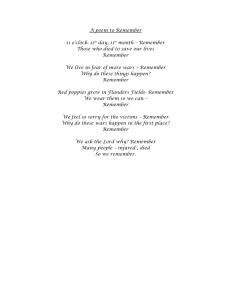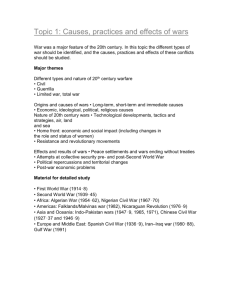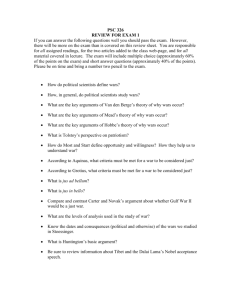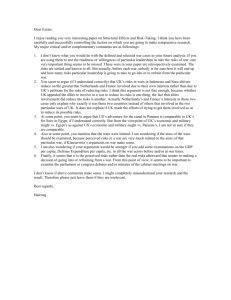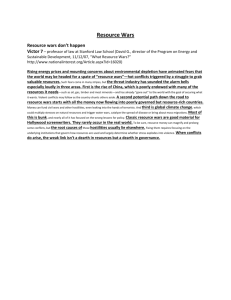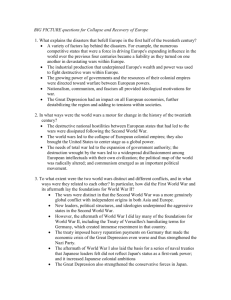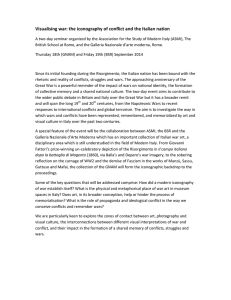Low Intensity Conflict
advertisement
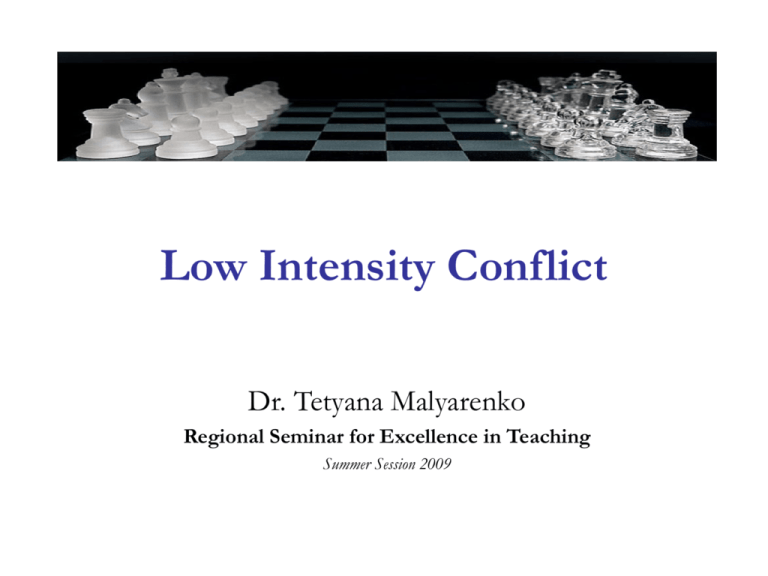
Low Intensity Conflict Dr. Tetyana Malyarenko Regional Seminar for Excellence in Teaching Summer Session 2009 Low intensity conflict The purpose of this module is to survey and critically examine theories that have been used to analyze specific type of conflict, such as low intensity conflict; to evaluate usefulness of these theories by applying them to specific case studies; and to encourage and assist participants to develop their own perspectives and to construct useful theories for conflict Topics: Fundamentals of low-intensity conflict; the law and low intensity conflict; the mass-oriented insurgency: how it organizes, how to counter it; selected case studies Course design Teaching objectives: • to survey and critically examine theories that have been used to analyze LIC; • to encourage and assist participants to develop their own perspectives and to construct useful theories for conflict Teaching mode: • Lecture with case-studies “Low Intensity Conflict”: 1. Introduction: transformation of war 2. Classification of conflicts and wars 3. Low intensity conflict: definitions, principal characteristics • Practicum “Campaign Design” Sample core reading • Martin van Creveld (1991) Transformation of War. New York: Free Press • James Gallagher (1992) Low Intensity Conflict: A Guide for Tactics, Techniques and Procedures. Stackpole Book • Robert E. Harkavy and Stephanie G. Neuman (2001) The Warfare in the Third World. Palgrave Macmillan • United States Marine Corps (2005) Small Wars Manual. University Press of the Pacific • Schelling C. Thomas (2007) The Strategy of Conflict. Harvard University “You may not be interested in war . . . but war is interested in you.” Leon Trotsky Introduction: Transformation of War 1. 2. 3. 4. 5. 6. The changing nature of conflict – main variables: Main protagonists and units of analysis of war (states, non-state actors, public and private actors, terrorist groups, and warlords); The primary motives of protagonists (e.g. ideology, territorial secession, material aggrandizement); The spatial context: interstate, “civil”, regional, global; Technological means of violence – weapons and strategies of war; The social, material and human impact of conflict, patterns of victimization and forced human displacement Political economy and social structure of conflict Definition of War War is “the continuation of policy by other means”… War is “an act of violence intended to compel our opponent to fulfil our will”… War is like a duel, but on “an extensive scale” Carl von Clausewitz War is an actual, intentional and widespread armed conflict between political communities – Michael Walzer, “Just and Unjust Wars”; War is a phenomenon which occurs only between political communities, defined as those entities which either are states or intend to become states. All warfare is precisely, and ultimately, about governance. War is a violent way for determining who gets to say what goes on in a given territory, for example, regarding: who gets power, who gets wealth and resources, whose ideals prevail, who is a member and who is not, which laws get made, what gets taught in schools, where the border rests, how much tax is levied, and so on. (Dictionary of War) War is profoundly anthropological: it is about which group of people gets to say what goes on in a given territory New wars 1) Most wars today are intrastate rather than interstate, interstate wars have declined in number while intrastate wars have increased; 2) New wars are characterized by state failure and a social transformation driven by globalization and liberal economic forces, competition over natural resources and illegal commercial entrepreneurship, private armies, and criminal warlords; 3) Ethnic and religious conflict is more characteristic of new wars than political ideology; 4) Civilian casualties and forced human displacement are dramatically increasing as a proportion of all casualties in conflict; 5) Civilians are increasingly deliberately targeted as an object of new wars; 6) Atrocities and ethnic homogenization are key hallmarks of contemporary conflict; and a breakdown of public authority blurs the distinction between public and private combatants, and between combatants and civilians. Warlords Warlords are armed combatants who defend their interests through the use of violent force. Their objectives may be material, identity-based, or ideological – and are often a combination of all three. The idea of set-piece battles and conventional armies is far from this scene Political Economy of Conflict Classical links between political economy and security studies: 1. Political economy of power; 2. Economic causes of war. The social and economic context of new wars: • weak or failed states, a collapse of the formal economy, and rivalry between criminal groups over natural resources or illegal commercial activities. • globalization: the age of globalization is characterized by a gradual erosion of state authority’ and accompanying ‘violent war economies’’; … the new wars are characterized by a multiplicity of types of fighting units both public and private, state and non-state, or some kind of mixture’ • motives…the goals of the new wars are about identity politics in contrast to the geopolitical or ideological goals of earlier wars’ (Kaldor, 2001) New wars and state failure: the concept Concept of ‘fragile states’ describes a range of phenomena associated with state weakness and failure, including state collapse, loss of territorial control, low administrative capacity, political instability, neo-patrimonial politics, conflict, and repressive polities (The World Bank, OSCE) State failure covers a wider range of civil conflicts, political crises, and massive human-rights violations that are typically associated with state breakdown” (the CIA, the USA) State failure is a gradual process and that states engulfed in it fall into four broad categories: weak, failing, failed and collapsed states Weak, failing, failed and collapsed states—the most common adjectives used in this context—were considered, quite correctly, as sources of insecurity and instability beyond their own boundaries, creating more or less complex humanitarian emergencies The empirical case for comparative and regional perspective: LICUS (The World Bank), The Failed States Index (The Fund for Peace), etc. Globalization and new war thesis First process underpins changes in the state – particularly an erosion of state authority and public goods – and social vulnerability. Second, globalization generates increased opportunities for economic motives in civil war as a result of transborder trade, both legal and illegal. Human and legal aspects of war The ‘strategies and tactics that deliberately target women, children, the poor, and the weak’, 90 percent of those killed in conflict are non-combatants. ‘Behavior that was proscribed according to the classical rules of warfare and codified in the laws of war in the late nineteenth century and early twentieth century, such as atrocities against noncombatants, sieges, destruction of historic monuments, etc., now constitutes an essential component of the strategies of the new mode of warfare (Kaldor, 2001a: 8). Case-study “War against Civilians: Sieges, Hostages and Blockades” Total war: Siege is the oldest form of total war. Its long history suggests that neither technological advance nor democratic revolutions are the crucial factors pushing warfare beyond the combatant population. Civilians have been attacked along with soldiers, or in order to get at soldiers, as often in ancient as in modern times. The siege of Leningrad Low intensity conflict: Civilians become military targets, and in the process, the most hideous crimes and violations of basic human rights. One of the military tactics is to remove the support that insurgency receives from the local population The 2002 Dubrovka and 2004 Beslan Hostage Crises Classification of conflicts and wars The Correlates of War (COW) project The Armed Conflict Dataset (ACD) The State Failure Project Use of violence as main criterion of definition 1. COW: War is defined as sustained combat between/ among military contingents involving substantial casualties (minimum of 1,000 battle deaths). Wars are subdivided into three categories (1) Inter-state wars, fought between two or more state members of the inter-state system; (2) Civil wars, fought within the "metropole" of a member state of the system by forces of the regime against an insurgent group; (3) Extra-systemic wars, fought between a member of the inter-state system and a territorial and political entity not recognized as a part of that system. COW: modification of typology 1. 2. • • Inter-state wars; Intra-state wars - between or among two or more groups within the internationally recognized territory of the state: Civil wars involving the state government and a non-state actor: (a) wars for control of the central government, (b) wars over local issues, including secession. Inter-communal conflicts involving two or more groups, none of which is the state government. 3. Extra-state wars • • State versus independent non-state actor; State versus dependent non-state actor Civil war: definition 1. 2. 3. 4. Four main characteristics: It requires that there is organized military action and that at least 1,000 battle deaths resulted; Effective resistance, at least five percent of the deaths have been inflicted by the weaker party; National government at the time has to be actively involved The level of violence. Minor conflicts produce more than 25 battle-related deaths per year, intermediate conflicts produce more than 25 battle related deaths per year and a total conflict history of more than 1,000 battle related deaths and lastly wars are conflicts which result in more than 1,000 battle related deaths per year Trends in modern wars Number of armed conflicts by level, all types, 1946-2001 “Old” and “new” civil wars: a comparative analysis Old civil wars New civil wars Causes and motivation Collective grievance Private loot Support Broad popular support Lack of popular support Violence Controlled violence Gratuitous violence Low intensity conflict (warfare) : definitions (1 of 3) LIC is a combination of various military and non-military concepts, often not precisely defined. Most theoreticians on LIC: 1) LIC is an integrated political-economic-military approach, supplemented by psychological, social and diplomatic devices; Conceptually it is primarily a political oriented and integrated policy approach containing military elements and not first military matter; 2) Relatively little military input; The aim is not military conquest, but social control…military may be employed as an element of struggle; Military is a tactical element of a strategic program; use of diplomatic and political means may be unlimited. 3) Most appropriate to the Third World; "LIC IS A LIMITED POLITICO-MILITARY STRUGGLE to attain political, military, social, economic or psychological objectives. It is often of lengthy duration and extends from diplomatic, economic and psychological pressure to terrorism and insurgency. LIC is generally confined to a specific geographical area and is often characterized by limitations of armaments, tactics and level of force. LIC involves the actual or contemplated use of military means up to just below the threshold of battle between regular armed forces” (The U.S. Army’s training manual, U.S. Army War College, Carlisle) Low intensity conflict (warfare): definitions (2 of 3) 1) 2) LIC is a political-military confrontation, ranging from propaganda and subversion to the actual use of armed forces, between contending states or groups below the level of conventional war and above the level of routine, peaceful competition. It frequently involves protracted struggles of competing principles and ideologies (The Essential Dictionary of the U.S. Military, 2001) This definition reveals two important elements: Civilian aspects are also being stressed; LIC is a term embracing many types of conflict Low-intensity conflict: definition (3 of 3) Principal characteristics of low-intensity conflicts: 1) They tend to unfold in “less developed” parts of the world; 2) Very rarely do they involve regular armies on both sides; 3) Most LICs do not rely primarily on the hightechnology weapons (Martin van Creveld, Transformation of War) Low-Intensity Operations and Campaign Design LIC operation is a military term for the use of troops and/or assets in situations other than war. Generally these operations are against non-state actors. Counterinsurgency aims primarily at preventing, impeding and defeating anti-government forces or movements in open civil war or similar military conflict; Counterinsurgency relies strongly on elements of economic aid, development assistance, psychological measures and diplomatic initiatives; The military component of low intensity conflict (1 of 2) 1. Professional army against a network of guerrilla organizations; Examples: wars in Afghanistan and Chechnya. 2. Present military powers are not relevant to defend the interests and prevent terrorism close to their home; 3. Forces are designed as for conventional wars, command structure is too tall; battle procedures are too cumbersome. The basic postulate is that, already today, the most powerful modern armed forces are largely irrelevant to modern war. The military component of low intensity conflict (2 of 2) • • This reveals the general focus of new policy in lowintensity warfare: To adjust the entire foreign policy machinery, not least armed forces, in line with the changed deployment conditions; Within the military, the aims are to define the conditions and circumstances governing "low-intensity" operations, to develop a corresponding military doctrine, to adapt military thinking within the military to these requirements and to implement the new doctrine in the recruitment and training of military personnel and in the allocation of arms and equipment to the forces. Weapons and Tactics: reduced tempo, fewer soldiers, reduced range of tactical equipment, limited scope to operate in a military manner Stages and elements: “soft power”: IO, propaganda => identification and removal of the local armed groups NATO and partners’ rationale for low intensity conflict The increased NATO commitment to LIC operations has two reasons: The first: main threat to Western interests today comes from the Third World, stems from local or regional conflicts and internal instability of West’s allies or clients: Morocco, Sudan, Egypt, Israel, Saudi Arabia, Mexico, Pakistan, the Philippines and the Republic of Korea - are all vulnerable to internal unrest and/or external attack... Internal instability, possibly leading to a revolution, is a more probable scenario in many of these countries. At the same time NATO military planers postulate that conflicts in Third World countries are linked to development failures: immature governments, emerging economies, population explosions and social problems, which have something to do with insufficient food supplies, poor health service and a high rate of illiteracy. This insurgency often takes place in areas with rich deposits of natural resources of considerable interest to the West. Small group exercise Conflict over property rights in the Crimea (“capture of the land”); Criminal wars in the early 90’s; Somali pirates; Conflict over illegal exploitation of mineral resources; Color revolutions in Ukraine and Georgia; Street protests in Iran and Moldova (elections 2009); Conflict between the President and Prime-Minister of Ukraine; Conflict between Mikhail Saakashvili and opposition; Activity of skinhead organizations in Russia and Ukraine 1. 2. 3. 4. To identify low-intensity conflicts from the list; to explain criteria (why), causes, actors, mechanism; To name some lowintensity conflicts taking place in participants’ home countries; To analyze LIC operations in the terms of tools, failure/success; To discuss the definition of LIC from the participants’ perspective and experience

